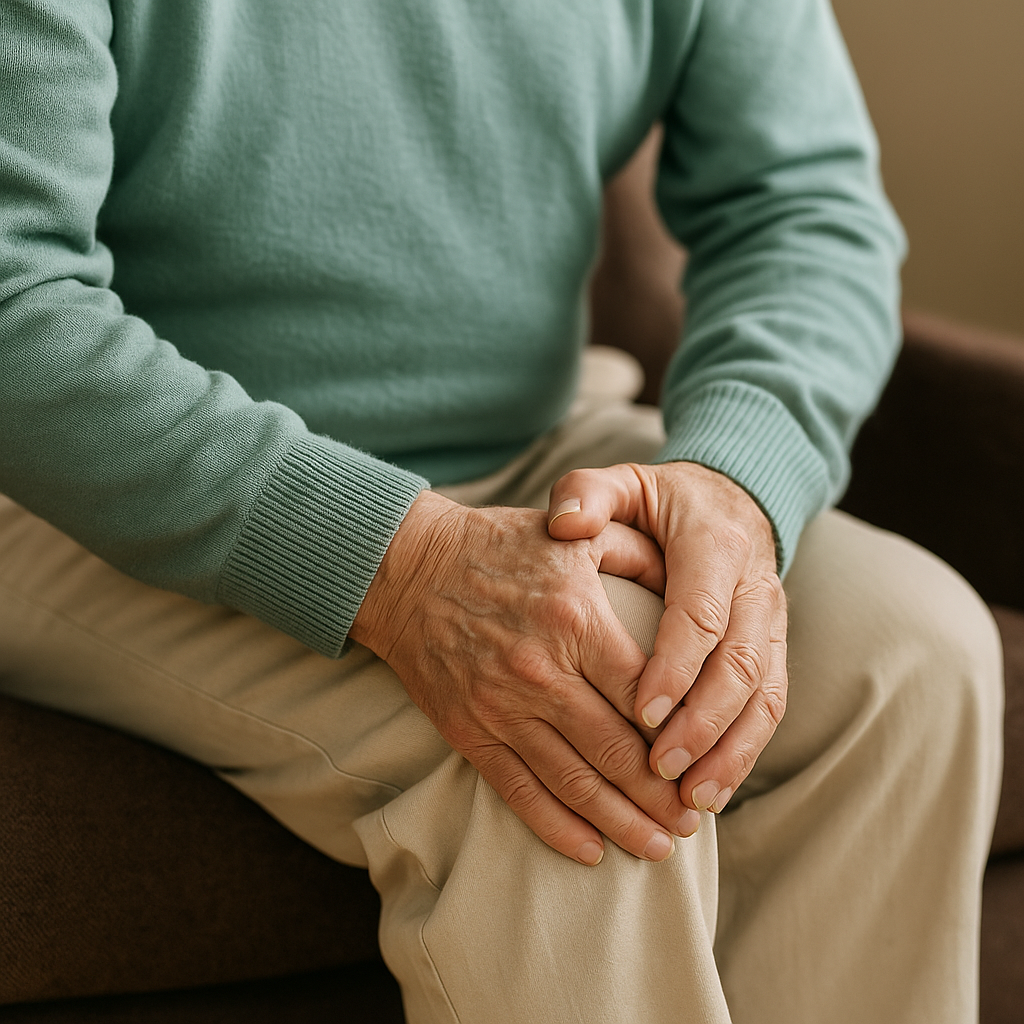For millions of older adults, pain doesn’t just show up in the morning — it shapes the day. Simple routines like opening jars, taking the stairs, or getting out of bed can suddenly feel like small battles. If you’ve ever paused mid-movement because a joint sent a sharp reminder, you’re not alone — and you’re not powerless.
Arthritis affects nearly half of adults over 65, but pain management today is very different from decades ago. We now understand that motion, mindset, and maintenance work together. The goal isn’t only to reduce pain — it’s to rebuild confidence and independence.
💬 Pain may live in your joints, but it shouldn’t control your life.
Understanding Arthritis Without the Fear
“Arthritis” simply means inflammation of the joints, but that inflammation can have many causes.
The two most common types are:
- Osteoarthritis (OA): The protective cartilage that cushions your bones wears down over time, often in knees, hips, spine, and hands.
- Rheumatoid Arthritis (RA): A chronic autoimmune condition that causes the immune system to mistakenly attack joint linings, creating swelling and stiffness.
Others, such as gout or psoriatic arthritis, bring their own challenges — but the goal is the same: control inflammation, protect movement, and stay active safely.
The pain is real, but it’s also manageable when you understand how joints respond to movement, temperature, nutrition, and rest.
The Balance–Pain Cycle (and How to Break It)
Joint pain changes how you move. Maybe you start avoiding certain stairs, or stop kneeling to garden. That small hesitation makes nearby muscles weaker — and weak muscles stop supporting your joints.
This creates the pain–inactivity loop:
Pain → Less Movement → Muscle Weakness → Poor Balance → More Pain.
Breaking that loop requires a shift in mindset: move a little every day, even when you don’t feel perfect.
Gentle motion brings blood flow, lubrication, and healing nutrients back to the joint. The less you move, the less nourishment your joints receive.
🌿 Movement is not your enemy — it’s your medicine.
1. Keep Moving — The Right Way
Rest feels safe, but stillness stiffens joints. A few minutes of daily motion can ease stiffness more than hours of sitting with heat packs.
Start with range-of-motion stretches: slowly bend and extend your knees, wrists, or fingers. Add gentle circles at the ankles and shoulders.
Follow with low-impact exercise:
- Walking — 10-15 minutes a day to warm up the body.
- Water aerobics — buoyancy eases pressure on hips and knees.
- Tai Chi or chair yoga — builds coordination and calm breathing.
- Resistance bands — strengthen without strain.
If pain flares afterward, apply ice for 10 minutes — don’t quit. Soreness means muscles are re-awakening.
🧘 You’re not chasing youth — you’re nurturing freedom of movement.
2. Strength and Weight: Two Quiet Influencers
Strong muscles act like shock absorbers around your joints. When they weaken, bones take the hit.
Adding light strength work — even two days a week — can dramatically improve stability. Focus on the thighs, hips, and core, which control balance.
Weight also matters. Every pound adds roughly four pounds of pressure to the knees.
A modest 8-10 pound loss can relieve dozens of pounds of stress from joints. Combine protein-rich meals with gentle exercise and hydration — no extreme dieting needed.
⚖️ Every healthy pound lost is a gift to your knees.
3. Comfort from Heat and Cold
Temperature therapy is simple yet powerful:
- Warmth (20 minutes): Loosens stiff joints before stretching or morning activity.
- Try a heating pad, warm towel, or shower.
- Cold (10 minutes): Reduces swelling and inflammation after exercise.
- Use an ice pack wrapped in cloth.
Rotate them as needed. Some seniors swear by paraffin wax hand baths for finger arthritis — they soothe, moisturize, and relax tendons simultaneously.
4. Ergonomic and Supportive Tools
Modern aids are discreet and effective:
- Cushioned shoe inserts reduce shock on knees.
- Jar openers and wide-grip utensils ease hand strain.
- Raised toilet seats or grab bars improve confidence and balance.
- Compression gloves or knee sleeves maintain warmth and gentle stability.
These small helpers turn frustration into independence.
🧤 Assistive tools don’t take your freedom — they give it back.
5. Physical Therapy: Re-training Strength and Trust
If you’ve stopped moving due to pain, a physical therapist can help you start again safely.
They’ll assess your posture, walking style, and muscle balance — then create a plan with gentle stretching, strengthening, and balance exercises.
Therapy isn’t about athleticism — it’s about re-educating the body.
When muscles remember how to support the joints, even arthritic joints can move more smoothly.
Some clinics offer aquatic therapy, using water to cushion motion. Others provide manual therapy, where the therapist mobilizes stiff joints and tissues. Both are safe and effective for older adults.
🩺 Confidence returns when you feel your body cooperate again.
6. Eat to Ease Inflammation
Food can worsen or soothe arthritis symptoms.
Eat more of:
- Fatty fish (salmon, sardines, mackerel) for omega-3s
- Olive oil instead of butter
- Leafy greens and berries rich in antioxidants
- Turmeric, ginger, and garlic for natural anti-inflammation
Eat less of:
- Processed meats and refined carbs
- Excess sugar or fried foods
- Too much alcohol or soda
Pair nutrition with hydration — water lubricates joints and flushes out waste products that cause stiffness.
🥗 Inflammation begins in the kitchen long before it reaches your knees.
7. Beyond Pills: Integrative Relief
Medication can help — but it’s not the whole story. Complementary care often improves outcomes without side effects:
- Massage therapy: Loosens tight muscles and improves circulation.
- Mind–body methods: Deep breathing, guided imagery, or meditation reduce pain perception.
- Topical creams: Menthol, capsaicin, or CBD balms offer temporary relief.
- Acupuncture: Increasingly used for chronic pain and stiffness.
Always tell your doctor about new therapies to avoid conflicts with prescriptions.
8. Know When to Call the Doctor
Don’t ignore warning signs that pain is changing:
- Persistent swelling or redness
- Joints that feel hot to the touch
- Pain that wakes you at night
- Sudden weakness or joint locking
Your provider can check for worsening inflammation or medication side effects, and may suggest updated imaging or injection options such as hyaluronic acid or cortisone.
🚨 Early treatment prevents permanent joint damage — never “tough it out.”
9. For Caregivers: Small Acts, Big Relief
Arthritis care is teamwork. You can’t remove pain, but you can make each day smoother:
- Offer to join short walks — companionship improves compliance.
- Keep comfort items (heat pads, braces) nearby and charged.
- Encourage hydration and anti-inflammatory snacks.
- Recognize emotional fatigue — pain wears on patience too.
❤️ Patience, empathy, and gentle reminders are medicine in their own right.
Final Thoughts
Arthritis doesn’t define you. It’s part of your story, but not your whole book.
You may move slower, but you’re still moving — and that’s what matters most.
Through balanced nutrition, gentle movement, warmth, and consistent support, you can stay active, strong, and hopeful.
💪 Pain might visit, but it doesn’t have to stay.
The path to comfort is built one steady step at a time — and you’re already on it.
Recommended Reading
- Nutrition & Hydration for Better Balance: Fuel your joints from the inside out.
- Physical Therapy for Strength and Balance: Learn how guided movement restores trust in your body.
- Safe Movement at Home: Simple home changes for pain-free mobility.
💬 Frequently Asked Questions
1. What is the best way for seniors to relieve arthritis pain naturally?
Start with gentle daily movement and anti-inflammatory meals. Warm compresses relax stiff joints, while cold packs ease swelling. Foods rich in omega-3s, like salmon or walnuts, also help reduce inflammation naturally.
2. Does exercise make arthritis worse?
No — the right kind of movement actually helps. Low-impact activities such as walking, swimming, and chair yoga strengthen the muscles that support joints, improving stability and reducing pain over time.
3. What foods can help ease arthritis pain?
Eat more foods that calm inflammation: fatty fish, olive oil, berries, spinach, and turmeric. Limit processed foods, refined sugars, and fried items that can increase swelling and stiffness.
4. Are there safe home remedies for arthritis in seniors?
Yes. Warm baths, gentle stretching, massage, and using heat or cold therapy can all help. Staying active, maintaining a healthy weight, and using joint-supporting braces or compression gloves also make a big difference.
5. Can arthritis cause balance problems?
Yes. Pain and stiffness can change the way you walk or stand, which weakens supporting muscles and affects balance. Physical therapy and strengthening exercises help rebuild coordination and confidence.
6. How can caregivers support someone with arthritis?
Encourage consistent movement, help with meal prep that supports joint health, and make sure comfort tools like heating pads or braces are within reach. Most importantly, be patient and celebrate progress — it motivates healing.





